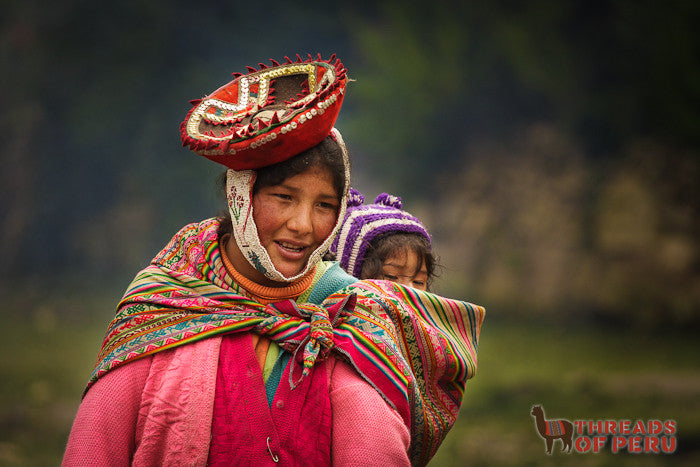
For two weeks we’ve been talking about dyeing workshops — about getting there and about the process. This third and final entry talks about the people behind our weavings.
I want to close my story about Threads of Peru’s dye workshop in the community of Rumira Sondormayo by talking about the women themselves. When I arrived on the field where the workshop was held, I was met mostly with sideways glances and little direct contact. Of course, the women of Rumira aren’t unfriendly, it’s just that I am new, foreign, male, and — if what I’ve been told is true — a little frightening in appearance (6’3”, 240lbs, big red beard).

I decided I would hang back a bit and observe, to let the women get comfortable with me and my camera. I watched as the women spooled dozens of meters of wool around their arms. I watched as they built fires, tended their children, and joked in Quechua.

I listened to the women laugh when someone told a funny story and giggle when someone pointed at me. I saw their skill in their products and witnessed their determination as they washed wool in the river.
The women of Rumira are not only artisans but also strong workers. I watched two women pull down a large branch for firewood and carry it across the river. Later I saw another women carrying a branch almost as large by herself. Many of the women work with their infants in blankets slung over their backs. If it wasn’t for the occasional sniffle or cry from the pouch, you wouldn’t even know they were carrying the extra weight. Once a pot of hot dye almost tipped over but two women caught it with their bare hands and held it for several seconds before someone with a blanket took over.

As the day went on, the women grew more comfortable with me. Both my Spanish and the women’s Spanish were limited but they did their best to answer my questions about the dyeing process when our master weaver, Daniel Sonqo wasn’t available. They even tried to talk to me in Quechua and we all laughed when it was clear I was completely lost.

When it came time to get names to go with photos, they were understandably shy but with the help of our guide, Urbano, who knew a few Quechua jokes himself, we were able to get a lot of smiles. One of the ladies even struck a pose for her photo, something that was completely unexpected.

Besides our weavers, there were a couple of children who spent the day at the workshop. One boy, who wore a bright red poncho, seemed to have an uncanny ability to tell when the camera was pointed in his direction. Every time I aimed my lens at him he would stop dead in his tracks, grab his nearest friend, and stand up straight facing directly at the camera. If it had been school picture day, this kid would have been a dream.

By the time we left I was beginning to recognize each woman and see their different personalities. Not wanting to overstep any culture boundaries, I had avoided touching or attempting to shake hands with any of the women. But right before we walked up the hill and back to the car, an older woman put out her hand to me. I extended mine and she grasped it in both of hers. She shook my hand firmly and thanked me for visiting. I returned the courtesies, smiled, and walked away.

The women of Rumira were captured on my camera’s sensor and in my mind. And I wouldn’t be surprised if the latter lasted longer.


